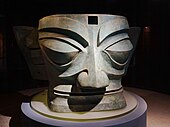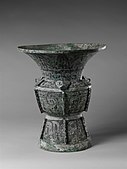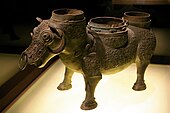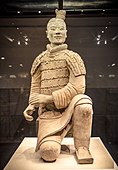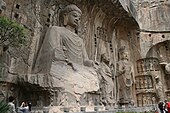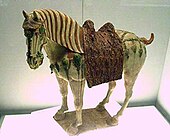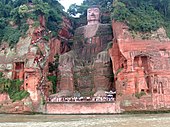Chinese sculpture

Chinese sculpture originated from the Shang, and has a history of more than 3,000 years.[dubious – discuss] Chinese sculpture eventually influenced the sculpture of other nations such as Japan.
Overview
Chinese ritual bronzes from the Shang and Western Zhou dynasties come from a period of over a thousand years from c. 1500 BC, and have exerted a continuing influence over Chinese art. They are cast with complex patterned and zoomorphic decoration, but avoid the human figure, unlike the huge figures only recently discovered at Sanxingdui.[1]
The spectacular Terracotta Army was assembled for the tomb of Qin Shi Huang, the first emperor of a unified China from 221 to 210 BC, as a grand imperial version of the figures long placed in tombs to enable the deceased to enjoy the same lifestyle in the afterlife as when alive, replacing actual sacrifices of very early periods. Smaller figures in pottery or wood were placed in tombs for many centuries afterwards, reaching a peak of quality in the Tang dynasty.[2]
Native Chinese religions do not usually use cult images of deities, or even represent them, and large religious sculpture is nearly all Buddhist, dating mostly from the 4th to the 14th century. One of the earliest Buddhist sculpture in China is a gilt-bronze seated Buddha with flame shoulders from the 3rd century, which displays influence from 2nd century Chinese tomb art and Khalchayan sculpture.[3] China Buddhism is also the context of all large portrait sculpture; in total contrast to some other areas in medieval China even painted images of the emperor were regarded as private. Imperial tombs have spectacular avenues of approach lined with real and mythological animals on a scale matching Egypt, and smaller versions decorate temples and palaces.[4] Small Buddhist figures and groups were produced to a very high quality in a range of media,[5] as was relief decoration of all sorts of objects, especially in metalwork and jade.[6] Sculptors of all sorts were regarded as artisans and very few names are recorded.[7]
The Terracotta Army, inside the Mausoleum of the First Qin Emperor, consists of more than 7,000 life-size tomb terra-cotta figures of warriors and horses buried with the self-proclaimed first Emperor of Qin (Qin Shi Huang) in 210–209 BC. The figures were painted before being placed into the vault. The original colors were visible when the pieces were first unearthed. However, exposure to air caused the pigments to fade, so today the unearthed figures appear terracotta in color. The figures are in several poses including standing infantry and kneeling archers, as well as charioteers with horses. Each figure's head appears to be unique, showing a variety of facial features and expressions as well as hair styles.
First monumental stone sculptures (117 BCE)

Terracotta (baked clay) statuettes were known for a long time in China, but there are no known examples of monumental stone statuary before the stone sculptures at the Mausoleum of Huo Qubing, a general of Emperor Han Wudi who went to the western regions to fight the Xiongnu.[8] In literary sources, there is only a single record of a possible earlier example: two alleged monumental statues of qilin (Chinese unicorns) that had been set up on top of the tomb of the First Emperor Qin Shihuang.[9] The most famous of Huo Qubing's statues is that of a horse trampling a Xiongnu warrior.[8] The Mausoleum of Huo Qubing (located in Maoling, the Mausoleum of Han Wudi) has 15 more stone sculptures. These are less naturalistic than the "Horse trampling a Xiongnu", and tend to follow the natural shape of the stone, with details of the figures only emerging in high-relief.[10] Zhang Qian (−114 BCE) too, the famous traveler to the western regions, had rudimentary stone statues of lions placed at his mausoleum.[11][12]
These precursors of Chinese monumental stone sculpture were probably influenced by their forays deep into Central Asia, where they probably encountered cultures using stone statues.[11] Recently, stone statues were discovered at the front of ancient tombs in the Altay and northern Xinjiang, which were probably influential.[11] The complex technology of stone sculpture seems to have followed a process of West-East diffusion, starting from Egypt and Babylonia to reach Greece, until finally reaching India with the Pillars of Ashoka (268–232 BCE) and China around the 2nd century BCE.[13]
- Crouching tiger, Huo Qubing Mausoleum
- Horse Ready to Leap, Huo Qubing Mausoleum
- Crouching boar. Huo Qubing Mausoleum
Buddhist sculpture
Chinese Buddhist sculpture has been produced throughout the history of Buddhism in China. Sculptural pieces include representations of Siddhārtha Gautama, often known as the "Enlightened One" or "Buddha", Bodhisattvas, monks and various deities. China was introduced to the teachings of Buddhism as early as the 2nd century BCE, during China's Han dynasty, becoming more established during the 2nd century CE.[14] The earliest representations did not start as sculptures of the human form, but rather an empty seat, footprint, tree or stupa, an architectural form eventually inspiring the creation of pagodas in China.[15]
The practice started in rock-cut cave temples where carvings, mostly in relief, of images enveloped chambers and complexes illustrating the beliefs associated to the Buddha's teachings. Creating these temples and sculptures not only garnered merit aligned to their own personal growth, but gave devotees a reference for worship and meditative inspiration.[16] Major rock-cut sites, with large groups of excavated caves, include the Yungang Grottoes, Longmen Grottoes, Maijishan Grottoes, and Mogao Caves.
Gallery
- Bronze mask, from Sanxingdui, 2nd millennium BCE
- Ding with Taotie engravings from the late Shang, c. 12th century BC. (further reading - Chinese ritual bronzes)
- Wine vase (zun); 13th century BC; bronze inlaid with black pigment; height: 40 cm; Metropolitan Museum of Art
- Spring and Autumn period ox-shaped vessel, 6th century BCE
- One of the warriors of the Terracotta Army, a famous collection of terracotta sculptures depicting the armies of Qin Shi Huang, the first Emperor of China
- Green glazed pottery dog Eastern Han, c.1st century CE
- Qilin statuette, Eastern Han, 1st century CE
- Changxin Palace lamp; circa 172 BC; bronze and gold; height: 48 cm; Hebei Provincial Museum (China); excavated from the tomb of Dou Wan
- Rhinoceroses roamed the plains of ancient China; unearthed from Shaanxi, 2nd century BCE
- The Flying Horse of Gansu; circa 300; bronze; height: 34.5 cm, length: 45 cm; width: 13.1 cm; Gansu Provincial Museum (Lanzhou, China)
- Votive stele with Buddha Shakyamuni; dated 542 (Eastern Wei dynasty); limestone; Museum Rietberg (Zürich, Switzerland)
- Reclining Buddha, Mogao cave
- Vairocana at Longmen Grottoes, 676 CE, during the reign of Empress Wu Zetian
- Sancai horse, Tang dynasty, c. 700 AD
- Sculpture probably of Amitābha; early 7th century; hollow dry lacquer with traces of gilt and polychrome pigment and gilding; height: 96.5 cm, width: 68.6 cm, depth: 57.1 cm; Metropolitan Museum of Art
- Wooden statue of Guanyin, Song dynasty
- The Leshan Giant Buddha, a 71 m tall stone statue, built between 713 and 803, Tang dynasty
- Statue of a monk; 8th century; limestone with pigment; limestone with pigment; height (including the stone dowel): 175.3 cm; Metropolitan Museum of Art
- Statue of the luohan Tamrabhadra, one of the group of glazed pottery luohans from Yixian; 10th–13th century; glazed terracotta; height: 123 cm; Guimet Museum (Paris)
- Bodhisattva Avalokiteshvara in water moon form (Shuiyue Guanyin); 11th century; wood (willow) with traces of pigment, multiple-woodblock construction; height: 118.1 cm, width: 95.3 cm, depth: 71.1 cm; Metropolitan Museum of Art
- Seated luohan; 18th–19th century; lapis lazuli; height: 18.1 cm, width: 25.4 cm; Metropolitan Museum of Art
References
- ^ Rawson, Chapter 1, 135–136
- ^ Rawson, 138-138
- ^ "China, Buddhist Art in ." Encyclopedia of Buddhism. Encyclopedia.com. (July 25, 2023). https://www.encyclopedia.com/religion/encyclopedias-almanacs-transcripts-and-maps/china-buddhist-art
- ^ Rawson, 135–145; 145–163
- ^ Rawson, 163–165
- ^ Rawson, Chapters 4 and 6
- ^ Rawson, 135
- ^ a b Qingbo, Duan (2022). "Sino-Western Cultural Exchange as Seen through the Archaeology of the First Emperor's Necropolis". Journal of Chinese History 中國歷史學刊. 7: 48–50. doi:10.1017/jch.2022.25. ISSN 2059-1632. S2CID 251690411.
Before the appearance of the large-scale stone sculptures in front of the tomb of Huo Qubing 霍去病 (d. 117 BCE) of the middle Western Han period (see Figure 9), no monumental works of sculptural stone art like this had ever been seen in Qin culture or in those of the other Warring States polities.
- ^ Qingbo, Duan (2022). "Sino-Western Cultural Exchange as Seen through the Archaeology of the First Emperor's Necropolis". Journal of Chinese History 中國歷史學刊. 7: 48–50. doi:10.1017/jch.2022.25. ISSN 2059-1632. S2CID 251690411.
There were two stone statues of qilin [Chinese unicorns]. The flanks of each animal bore carved inscriptions. These once stood atop the tomb mound of the First Emperor of Qin. Their heads stood one zhang and three chi in height [approx. three meters].
- ^ Qingbo, Duan (2022). "Sino-Western Cultural Exchange as Seen through the Archaeology of the First Emperor's Necropolis". Journal of Chinese History 中國歷史學刊. 7: 48–50. doi:10.1017/jch.2022.25. ISSN 2059-1632. S2CID 251690411.
The sixteen large stone sculptures in front of the tomb of the Han general Huo Qubing 霍去病 (ca. 117 BCE), are mostly sculpted following the form of the original stone (see Figure 9). They employ techniques such as sculpting in the round, raised relief, and engraved intaglio lines to carve stone sculptures of oxen, horses, pigs, tigers, sheep, a fantastic beast eating a sheep, a man fighting a bear, a horse trampling a Xiongnu warrior, and other images. It is hard to find any evidence in China for this type of crude but concise lifelike rendering before these monuments.
- ^ a b c Liu, Qingzhu (24 February 2023). A History of Un-fractured Chinese Civilization in Archaeological Interpretation. Springer Nature. p. 293. ISBN 978-981-19-3946-4.
- ^ For a photograph: "张骞墓(丝绸之路申遗项目)". 中国考古. 中国考古.
- ^ Qingbo, Duan (January 2023). "Sino-Western Cultural Exchange as Seen through the Archaeology of the First Emperor's Necropolis". Journal of Chinese History. 7 (1): 48–49. doi:10.1017/jch.2022.25. ISSN 2059-1632.
Looking at materials from along the route of the classic "Silk Road," the techniques of stone inscriptions and stone sculpture shows signs of having diffused from the West to the East. The practice was first transmitted from Egypt and Babylonia to Greece, and then throughout the Mediterranean islands and coastal areas. After that, from the territory of the Persian Empire, it spread to India during the Mauryan dynasty in the time of Ashoka, to Pakistan and Afghanistan, and finally arrived in China.
- ^ Leidy, Denise. "Chinese Buddhist Sculpture | Essay | Heilbrunn Timeline of Art History | The Metropolitan Museum of Art". The Met’s Heilbrunn Timeline of Art History. Retrieved 2017-11-19.
- ^ "Wisdom Embodied: Chinese Buddhist and Daoist Sculpture in The Metropolitan Museum of Art | MetPublications | The Metropolitan Museum of Art". www.metmuseum.org. Retrieved 2017-11-19.
- ^ "Chinese Buddhist Cave Temple Sculpture". Victoria and Albert Museum. Retrieved 2017-11-19.
Additional sources
- Edmund Capon and Mae Anna Pang, Chinese Paintings of the Ming and Qing Dynasties, Catalogue, 1981, International Cultural Corporation of Australia Ltd.
- Rawson, Jessica (ed). The British Museum Book of Chinese Art, 2007 (2nd edn), British Museum Press, ISBN 9780714124469
- Sickman, Laurence, in: Sickman L. & Soper A., The Art and Architecture of China, Pelican History of Art, 3rd ed 1971, Penguin (now Yale History of Art), LOC 70-125675






